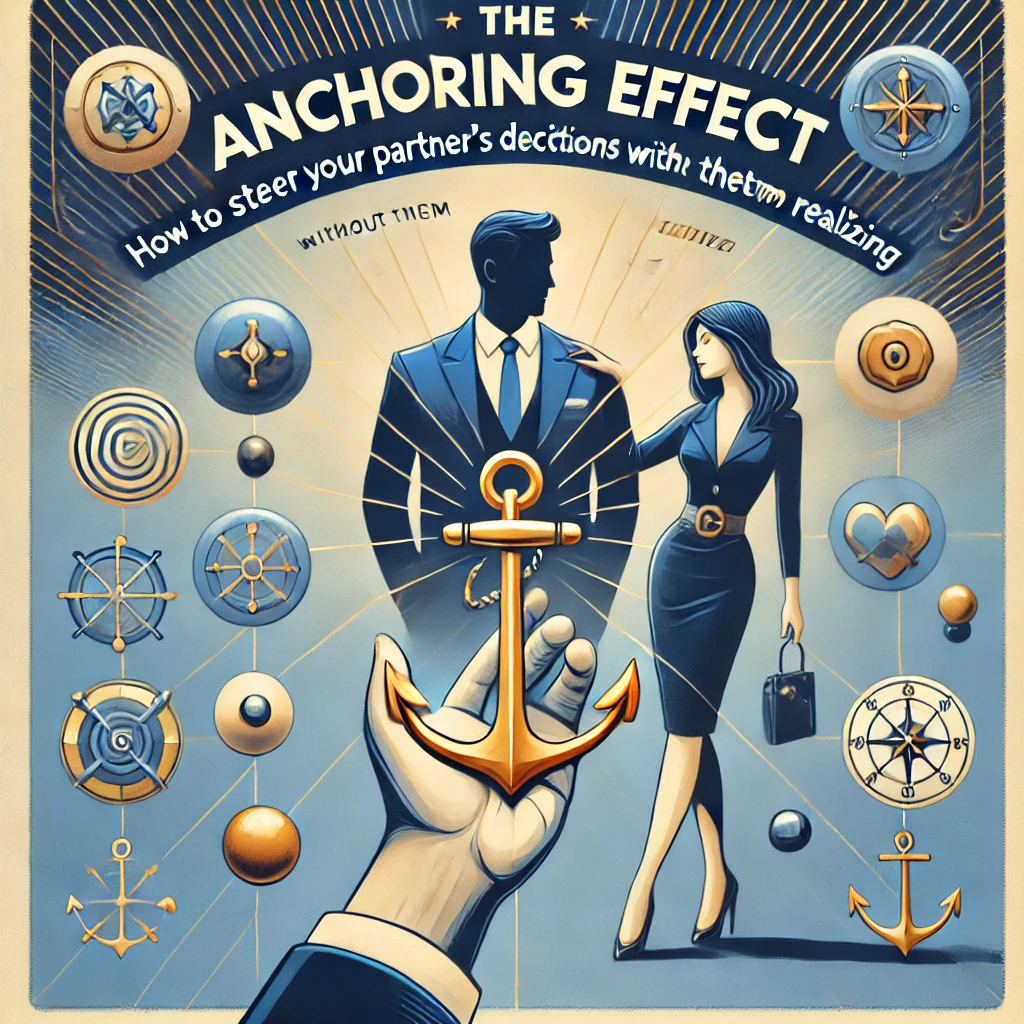In relationships, decision-making is often a delicate dance. Whether you’re discussing vacation plans, finances, or even what to have for dinner, influencing your partner’s choices in a way that feels natural can be tricky. But what if there was a subtle, effective way to steer your partner’s decisions without them even realizing? Enter The Anchoring Effect, a powerful psychological technique that can help you gently nudge your partner toward the outcome you want, all while making them feel like the decision was entirely their own.
The Anchoring Effect is a cognitive bias where people rely heavily on the first piece of information they receive (the “anchor”) when making decisions. Once that anchor is set, it influences all subsequent thoughts and decisions. In a relationship, you can use this to your advantage by setting the initial point of reference in conversations, guiding your partner toward a specific conclusion. Whether you’re negotiating, suggesting a plan, or discussing future goals, the Anchoring Effect can help you shape the conversation from the start.
In this blog, we’ll explore how the Anchoring Effect works, why it’s so effective in relationships, and provide practical, relatable examples that show how you can use it to subtly influence your partner’s choices. By the end, you’ll understand how this technique can make decision-making smoother and more aligned with your goals.
What Is The Anchoring Effect?
The Anchoring Effect refers to the human tendency to rely heavily on the first piece of information offered (the anchor) when making decisions. Once the anchor is established, it becomes the reference point against which all subsequent decisions are made. For example, if you’re discussing how much to spend on a vacation and the first number mentioned is $5,000, that figure becomes the anchor—even if you ultimately decide to spend less, your decision-making is still influenced by that initial number.
In relationships, you can use this cognitive bias to subtly shape your partner’s decisions by setting the anchor yourself. By introducing the initial idea, figure, or concept, you influence how your partner perceives subsequent choices. The key is to make the anchor something that naturally guides them toward your desired outcome.
Why Does The Anchoring Effect Work?
The Anchoring Effect works because humans naturally rely on the first piece of information they receive when forming judgments or decisions. Once an anchor is set, it’s difficult to shift away from it, even when presented with additional information. People tend to compare all subsequent information to the anchor, making it a powerful tool for influencing decisions.
In relationships, this effect can be used to guide conversations and negotiations. By setting the initial anchor, you frame the discussion in a way that naturally leads your partner toward the decision you want. They feel like they’re making a choice, but in reality, you’ve already steered the conversation in a specific direction.
How to Use The Anchoring Effect in Relationships
Let’s explore some practical, real-life examples of how you can use the Anchoring Effect in your relationship to gently influence your partner’s decisions.
Example 1: Planning a Big Purchase Together
You and your partner are discussing making a significant purchase, like a new car, but you have different ideas about how much to spend. Instead of directly arguing for your preferred price, you can use the Anchoring Effect to frame the conversation.
How to Use The Anchoring Effect:
If you want to spend around $30,000 on the car, start by mentioning a higher figure first: “I’ve been looking at cars, and I saw this amazing model for $50,000. It has everything we’d ever need.” Even if your partner immediately balks at the price, you’ve set the anchor. When you later suggest the $30,000 car, it will seem like a much more reasonable compromise by comparison.
Why It Works:
By anchoring the discussion with a higher price, you make your actual target (the $30,000 car) feel more affordable and reasonable. Your partner is likely to view the second option more favorably because it feels like a better deal after hearing the higher anchor.
Example 2: Deciding on Vacation Plans
You’re planning a vacation together, but you and your partner have different ideas about where to go or how much to spend. Instead of pushing for your preferred destination outright, you can anchor the conversation by introducing a more extravagant option first.
How to Use The Anchoring Effect:
Start by suggesting a luxurious, high-end vacation: “What do you think about a two-week trip to Bora Bora? It’s on my dream list, but it might be a little expensive.” After discussing the high cost and time commitment of Bora Bora, suggest your actual preference: “Or maybe we could do a week in Hawaii instead—it’s closer and more affordable.” By comparison, the Hawaii trip will seem like a more reasonable and attractive option.
Why It Works:
The Bora Bora suggestion serves as the anchor, making Hawaii feel like a more affordable and realistic alternative. Your partner is more likely to agree because the second option feels like a compromise.
Example 3: Discussing Household Budgets
Budgeting can be a source of tension in many relationships, especially when one partner is more conservative with spending. The Anchoring Effect can help you guide financial discussions in a way that feels fair to both of you.
How to Use The Anchoring Effect:
If you want to allocate more money for a home renovation, start by discussing a higher, more ambitious figure: “I’ve been thinking we could spend $20,000 on this kitchen remodel to really make it amazing.” Even if your partner rejects the high figure, you’ve anchored the conversation at that number. When you later suggest $12,000 as a compromise, they’re more likely to agree because it feels like a middle ground.
Why It Works:
The $20,000 figure sets the anchor, making the $12,000 option seem more reasonable. Your partner feels like they’re saving money while still getting something substantial.
Example 4: Getting Your Partner to Agree to More Quality Time
Let’s say you want to spend more time together, but your partner is busy with work or other commitments. You can use the Anchoring Effect to guide them toward agreeing to your desired amount of time without making them feel pressured.
How to Use The Anchoring Effect:
Start by suggesting a significant time commitment: “I’d love it if we could spend the whole weekend together, just the two of us.” When your partner explains that they can’t commit to the entire weekend, you can suggest a smaller alternative: “Okay, how about just Saturday afternoon and evening?” By anchoring with the larger request, your partner is more likely to agree to the smaller, more manageable option.
Why It Works:
The initial suggestion sets the tone for the conversation, making the smaller time commitment feel more reasonable. Your partner will be more inclined to agree because it feels like a fair compromise.
Example 5: Negotiating Chores or Responsibilities
If you’ve been trying to get your partner to take on more responsibilities around the house, the Anchoring Effect can help you frame the conversation in a way that leads to a fair division of tasks.
How to Use The Anchoring Effect:
Start by suggesting that your partner take on a larger portion of the chores: “Do you think you could handle all the cleaning this week while I focus on work?” When they push back, offer a more balanced alternative: “Okay, how about we split it—maybe you take care of the kitchen and I’ll do the laundry?” The second suggestion feels more reasonable in comparison to the initial anchor, making it easier for your partner to agree.
Why It Works:
The larger ask sets the anchor, so when you follow up with the more balanced suggestion, your partner feels like they’re getting a fairer deal. They’re more likely to agree because it seems like a compromise compared to the initial suggestion.
Why The Anchoring Effect Works in Relationships
The Anchoring Effect is effective because it takes advantage of how people process information and make decisions. Once an anchor is set, it influences how subsequent options are evaluated. In relationships, this can help you guide discussions toward outcomes that work for both partners, without creating conflict or pressure.
By setting the initial anchor, you shape the entire conversation in a way that aligns with your goals. Your partner still feels like they’re making their own decision, but in reality, you’ve already framed the discussion to lead them toward a specific outcome.
Tips for Using The Anchoring Effect in Your Relationship
Here are some key tips for using the Anchoring Effect effectively:
- Set a Realistic Anchor: The anchor should be higher than what you actually want, but not so extreme that it feels ridiculous. It needs to be something your partner can take seriously, even if they ultimately reject it.
- Be Willing to Compromise: The key to using this technique successfully is framing the final option as a compromise. Make your partner feel like they’re getting a good deal compared to the initial anchor.
- Use It Sparingly: Don’t overuse the Anchoring Effect in every conversation. It’s most effective when used in situations that require negotiation or compromise.
- Frame It Positively: When presenting the anchor, keep the tone positive and collaborative. You’re guiding the conversation, not forcing a decision.
Q&A:
- What is the Anchoring Effect in psychology?
Discover how the Anchoring Effect influences decision-making and how it can subtly shape your partner’s choices in relationships. - How can I use the Anchoring Effect in my relationship?
Learn practical ways to use the Anchoring Effect to guide your partner’s decisions and create harmony in your relationship. - How does the Anchoring Effect work in decision-making?
Understand why the first piece of information presented in a conversation becomes the anchor and how it impacts decisions. - Can the Anchoring Effect improve communication in relationships?
Discover how using anchors can help facilitate discussions, negotiations, and decisions with your partner. - What are examples of the Anchoring Effect in everyday life?
See real-life examples of the Anchoring Effect in action, from budgeting to planning vacations, and learn how to apply it in your relationship. - Is the Anchoring Effect a form of manipulation?
Explore the ethical considerations of using the Anchoring Effect to influence decisions in a positive way without manipulating. - How can I set an effective anchor in a conversation?
Learn tips for setting a realistic and persuasive anchor that helps guide decisions without creating pressure. - Why do people rely on the first piece of information they hear?
Understand the psychology behind the Anchoring Effect and why it has such a strong impact on decision-making. - How does the Anchoring Effect apply to negotiations with a partner?
Discover how you can frame options in a way that promotes compromise and cooperation with your partner. - What are the benefits of using the Anchoring Effect in relationships?
Learn how this subtle influence technique can reduce conflict, make decisions easier, and create a stronger sense of teamwork in relationships.
Want to Master Subtle Influence in Your Relationship?
If you’re ready to take your influence skills to the next level and learn how to guide your relationship toward the outcomes you want, **”Mastering Him: The Secret Art of Gentle Control
in Relationships”** is the ultimate guide for you. In Chapter 5, you’ll dive deeper into The Anchoring Effect and discover 12 other powerful strategies to subtly influence your partner’s behavior, decisions, and emotions.
Get your copy today and start mastering the art of influence in your relationship. It’s time to shape the outcomes you want with confidence, using the power of subtle psychological techniques.
Read more about the book: https://developmentpill.com/mastering-him-the-secret-art-of-gentle-control-in-relationships-a-guide-to-influence-hell-never-see-coming/
Book Link: https://www.amazon.com/dp/B0DKKGLZQ9
Book Link UK: https://www.amazon.co.uk/dp/B0DKKGLZQ9
You can find book Links for other regions in this post page: https://developmentpill.com/mastering-him-the-secret-art-of-gentle-control-in-relationships-a-guide-to-influence-hell-never-see-coming/



